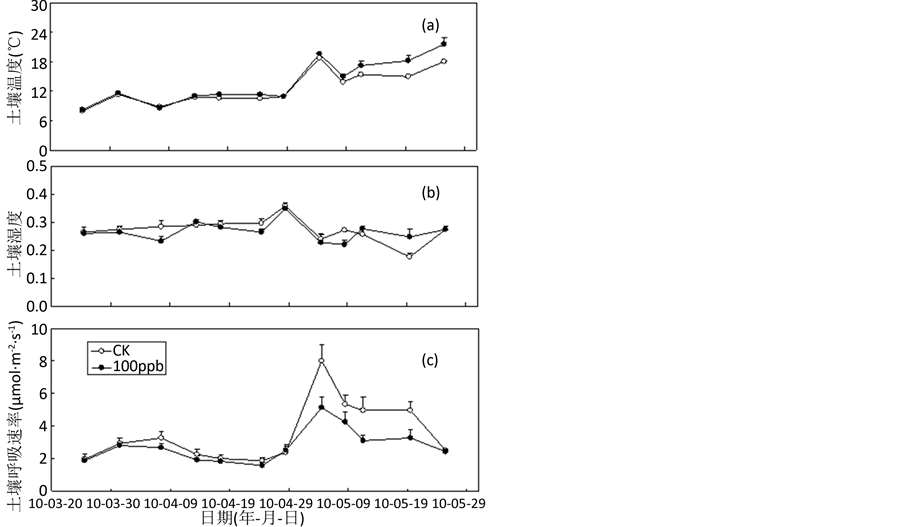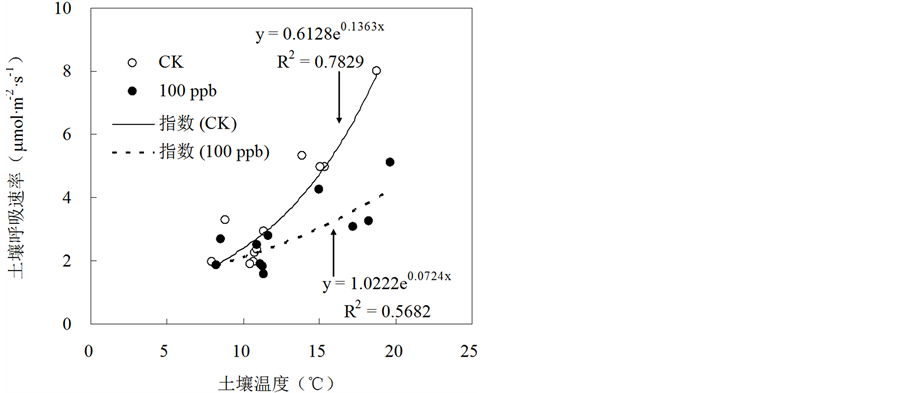1. 引言
臭氧是一种在地球对流层自然产生的光化学氧化剂,其背景浓度认为在0.025~0.05μmol∙mol−1。自工业革命以来,由于人类活动和工业生产的迅猛发展,地面向大气排放的污染物种类和数量不断增加,臭氧就是其中一种重要的污染气体。一些地区,臭氧浓度在过去一个世纪里明显升高,而且地面臭氧浓度大概每年升高0.3%~2% (Thompson, 1992; Vingarzan, 2004)。
自1958年Richards等 [1] 首次报道臭氧胁迫会伤害植物之后,学者们纷纷研究农作物、林木等的响应,发现臭氧可直接作用于植物叶片,促使气孔导度下降、光合作用受到抑制、叶面出现伤害等,进而导致生物量与生产力下降、作物减产 [2] 。目前已有文献报道高臭氧浓度对光合作用,产量具有影响,但关于臭氧浓度升高对农田土壤呼吸及硝化–反硝化作用影响的研究还是较少。事实上,臭氧浓度升高对农田土壤呼吸及硝化、反硝化作用的影响的研究非常有意义。
全球每年由于土壤呼吸(即土壤CO2排放)作用向大气中释放的碳的估算值约为68~80 Pg (Raich and Potter, 1995),农田系统的排放贡献占很大一部分。土壤呼吸是指土壤产生并向大气释放CO2的过程,它包括三个生物学过程,即土壤微生物呼吸、植物根系呼吸和土壤动物呼吸,和一个非生物学过程即含碳矿物质氧化与分解释放 [3] [4] 。土壤呼吸受到多种因素的影响,有非生物的:土壤温度、土壤水分、土壤养分、土壤有机质等;有生物的:地面植被、土壤微生物、土壤动物的组成、活性和功能等 [5] 。土壤呼吸具有明显的季节和日变化动态,而影响其的主导影响因子包括气候因子、土壤因子、植被和地表覆被物、大气CO2浓度以及人为干扰等 [6] 。其中温度是影响土壤呼吸的主要因素之一 [7] 。但是关于臭氧对土壤呼吸的影响现在有的研究较少。
农田土壤和热带地区的土壤,同样是全球最主要的N2O排放源,贡献率高达70% (Bouwman, 1989),N2O是重要的温室气体,对全球气候变暖的贡献是CO2的200倍 [8] ,进入大气后还能破坏高空中的臭氧层,直接危及大气层和生物圈。
农业土壤N2O主要来源于微生物活动引起的硝化和反硝化过程(Abbasi M. K. and Adams W. A., 2000)。硝化作用是铵态氮通过生物氧化生成亚硝态氮及硝态氮的过程。硝化过程受到生物、非生物因素和人类活动的调节和控制 [9] 。非生物因素主要是指土壤通气条件、含水量、pH等环境因子,生物因素的影响主要是通过植物根系、土壤微生物及动物的活动作用的。过程可表达如图1 [10] 。
生物反硝化是土壤微生物驱动的硝酸盐异化过程,主要由某些嫌气性和兼气性微生物完成。土壤反硝化作用也受到很多因素主要包括非生物因子如温度、水分条件和生物因子以及人类的活动的影响 [11] [12] [13] [14] 。普遍认为这一过程按图2路径进行 [15] 。
所以研究高臭氧浓度对农田土壤硝化和反硝化作用具有一定的环境和生态学意义,也越来越受到人们的重视。目前现有的实验研究对于深入的研究臭氧对于农田土壤硝化、反硝化作用的影响的研究较少。
本文归纳总结臭氧浓度升高对农田土壤呼吸、硝化及反硝化作用的影响,旨在全球变暖和近地层臭氧污染的情况下,为研究农田土壤排放CO2和N2O提供科学依据。
本研究采用开顶式气室(Open Top Chamber,简称OTC)大田试验,利用臭氧自动发生和调控系统模拟臭氧浓度升高环境,测定土壤呼吸速率、硝化与反硝化速率,探讨臭氧浓度升高对冬小麦农田土壤呼吸速率、硝化与反硝化速率的影响。
2. 材料与方法
2.1. 试验地点概况
实验地点设在南京信息工程大学农业气象试验站(32˚14N, 118˚42E),于2009~2010年冬小麦生长季期间进行田间观测试验。当地多年平均降水为每年1100 mm,多年平均温度为15.6℃。土壤为潴育型水稻土,灰马肝土属,耕层土壤质地为壤质黏土,黏粒含量为26.1%,土壤pH(H2O)值为(6.1 ± 0.2),有机碳、全氮的含量分别为19.4 g∙kg、11.5 g∙kg。
2.2. 试验设计
供试冬小麦品种为扬麦14号,在小麦的拔节期、孕穗期、抽穗期、灌浆期间进行测定。本次试验使用WH-H-Y10型高频O3发生器,臭氧装置采用直径3 m,高2.5 m的开顶式气室(OTC)作为臭氧布气的容纳装置来对供试作物进行臭氧熏蒸实验,设置CK、100 ppb两个臭氧浓度处理。通过气泵对臭氧发生器产生的臭氧进行预先稀释,之后吹入OTC内的布气装置,最终使OTC内均匀布满气体,OTC内设置

Figure 1. Schematic diagram of nitrification process
图1. 硝化作用过程示意图

Figure 2. Schematic diagram of denitrification process
图2. 反硝化作用过程示意图
臭氧浓度传感器(精度可达1 ppb,对臭氧浓度传感器进行预先设定浓度阈值,当OTC内臭氧浓度未达到此阈值时,臭氧发生器持续工作并向OTC内通入臭氧气体,当OTC内浓度超过此阈值时,则臭氧传感器则提示报警,其信号通过微型电子控制仪的指令控制与臭氧发生器相连的电磁阀断开,此时臭氧发生器停止工作。这样可实现OTC内臭氧浓度的自动调控O3浓度增加试验从3月10日开始,每天通气时间为:08:00~16:00 (雨天停止通气),每天O3浓度增加时间共计8个小时。水肥供应适量而充分,其他农田管理措施均相同,无病虫害及杂草的影响。
2.3. 土壤呼吸及硝化、反硝化作用的测定
2.3.1. 土壤呼吸的测定
土壤呼吸的测定采用LI-8100开路式土壤碳通量测量系统(LI-COR公司,美国)对土壤呼吸速率进行观测。
LI-8100开路式土壤碳通量自动测量仪,该测量仪上有五个指示灯:① Power;② Ready;③ IRGA Ready;④ Active;⑤ Low Battery。测量仪的硬件分析器控制单元、辅助传感器接口、串行电缆接口、标准RS-232电缆、压缩闪存卡、背带配件、长期室(8100-104)、调查室(8100-103)、备用零件用具包、校准单、土壤温度探头、土壤水分探头和Palm®/无线通讯包。
采用PVC制成的直径为22厘米的两头开口的圆筒作为测定土壤呼吸的取样底座。在测量前先将LI-8100开路式土壤碳通量自动测量仪的部件连接起来。将电池装上后打开电源开关预热10分钟,将土壤温度探头插到地上,探头插入地下的深度为5 cm,含水量探头插入土壤。
2010年3月臭氧熏蒸后,在各个实验处理的OTC内随机选取4株相邻冬小麦植株,并在其对角线交叉点安装PVC测量圈,每个处理设置两个重复。观测在8:00~11:00 (北京时间,下同)之间进行,采样频率为一周一次。
2.3.2. 硝化与反硝化作用的测定
硝化与反硝化作用的测定采用的是气压过程分离技术(Barometric Process Separation technique)简称BaPS,BaPS技术是测定总硝化作用和反硝化作用速率的一种新方法。BaPS实验容器上连接了温度(同时检测土温和上部空间的气温)、压力和CO2探头、O2探头。在实验容器的密闭空间内可以放置7个装有田间原状土柱的环刀。实验过程中需要土温和气温保持恒定,在BaPS系统中通过将实验容器放入水浴中以保持恒定的温度。
BaPS技术的原理 [16] 是:在通气良好的土壤中的CO2、O2和总的气体平衡、土壤呼吸系数为1.0的理论前提下,假定只有硝化作用、反硝化作用、土壤呼吸过程、CO2溶解于土壤水中,这几个过程与系统中的压力相关,根据压力平衡反过来可以精确计算出土壤样品的总硝化速率和反硝化速率。
在充气的压力体系中放进土柱,土壤呼吸、硝化和反硝化这些微生物的活动就会影响系统压力的改变。CO2溶解于土壤水中顶部空间里的气态CO2浓度和液相CO2浓度保持动态平衡。土壤呼吸过程是一个既不产生气体也不消耗气体的过程,这是因为土壤呼吸过程中消耗O2的量和生成CO2气体的量是相同的,保持了气压的平衡。
硝化反应使得系统内的压力降低,这主要是氨氧化细菌消耗O2。涉及主要方程 [17] 为:

而反硝化反应却使系统内的压力增加,这是由于反硝化过程中产生CO2和NO、N2O、N2等氮氧化合物气体。其涉及主要方程 [17] 为:

如果发现系统中的压力降低,那么系统中就发生了硝化反应。同样,如果发现系统中的压力增加,就说明系统中发生了反硝化反应。
每次采样时,在样地土壤表面用环刀(直径5.5 cm,高4 cm)原位取样。BaPS系统中3个环刀为一组,每个环刀在同一小区中随机采集不同样点,采后立即用塑料盖密封环刀,防止水分散失。因此,土壤硝化、反硝化速率是3个样点数值的平均,粗略地代表实验地的状况。采样结束后立即将装有土样的环刀送到实验室,利用减量法称出环刀内土壤的质量,输入计算机;pH和含水量经过测定后也输入其中。随后将环刀置于BaPS 实验容器,并检测仪器的气密性,然后进行测定,密闭测定过程为10 h。对极少数不能立即分析的土样先放入冰箱于0℃~4℃下保存,保存时间不超过1周。
测定结束后,选取10 h内气压变化曲线基本保持稳定的一段数据截取,最后经过线性回归拟合方程计算出结果。待土壤质量、含水量以及pH等参数都输入并计算后,记录下每次测定的土壤总硝化速率和反硝化速率。
2010年4月25日分别在100 ppb、CK两个臭氧浓度处理的OTC内选取典型样地,使用环刀(直径5.5 cm,高4cm)在土壤表层原位取样。
2.4. 土壤温度、土壤含水量的测定
土壤温度使用LI-8100开路式仪器进行测定,在土壤5 cm深处埋入温度计探头,仪器自动记录。
采用LI-8100开路式测定土壤含水量(质量含水量)。观测时将含水量探头插入土壤中,仪器自动记录。
2.5. 数据分析
利用Office Excel 2003软件作CK、100 ppb两个臭氧浓度处理下的土壤温度、土壤湿度及土壤呼吸速率的动态变化图。
采用SPSS 11.5统计软件,做出CK、100 ppb两个臭氧浓度处理下土壤呼吸和土壤温度、土壤湿度的关系的散点分析图;运用Pearson相关性分析,对CK、100 ppb两个臭氧浓度处理下对土壤CO2产生速率与硝化、反硝化速率的相关性进行分析。
3. 结果与分析
3.1. 臭氧浓度升高对土壤呼吸速率的影响
根据2010年3月20日起至2010年5月29日在南京信息工程大学农业气象试验站农田的数据制成图3,其为CK、100 ppb两个臭氧浓度处理下的土壤温度、土壤湿度及土壤呼吸速率的动态变化图。图3(c)显示出土壤的呼吸速率大致呈现先增加后减小的趋势,且不同处理下的土壤呼吸速率的最大值均出现在5月4日左右,并都在达到峰值后逐渐缓慢地下降。根据冬小麦主要生育期见表1,并结合图3(a)和图3(c)可以说明不同处理下的土壤呼吸速率在5月4日土壤呼吸速率达到峰值之前,都是随着土壤的温度的变化而变化,即随着温度的升高而升高,土壤呼吸和土壤温度的变化趋势一致;5月4日土壤呼吸速率达到峰值后,从图中可以很明显的看出,土壤呼吸速率并没有随着温度的升高而升高,而是呈现一种缓慢下降的趋势,土壤呼吸和土壤温度的变化趋势不一致。这说明在一段时期内(灌浆期前),温度是控制土壤呼吸速率大小的限制因子,但随着土壤灌浆后,温度的作用有明显削弱,其他影响因子作用抬升为控制土壤呼吸速率的重要因素,这时多种因子共同影响土壤呼吸 [18] 。结合图3(b)和图3(c),从图中可以看出,各处理下的土壤湿度对土壤呼吸速率的影响并不大,可以得出土壤湿度没有对土壤呼吸造成限制。就总体而言,臭氧浓度的升高没有改变冬小麦农田土壤呼吸的生育期内的规律。
从图3(c)可以看出虽然CK和100 ppb下土壤呼吸速率的趋势是大致一致,但是CK处理下的振幅较

Figure 3. The dynamic changes of soil temperature, soil moisture and soil respiration rate under CK, 100 ppb treated with ozone concentration
图3. CK、100 ppb两个臭氧浓度处理下的土壤温度、土壤湿度及土壤呼吸速率的动态变化图

Table 1. Main growing period of winter wheat and fertilizer management
表1. 冬小麦主要生育期和肥料管理
大,在峰值时为8.0 umol∙m−2∙s−1,而在100 ppb处理下的土壤呼吸速率的峰值为5.12 umol∙m−2∙s−1。可以得出,臭氧浓度的升高可能会降低冬小麦农田土壤呼吸的速率。
3.2. 臭氧浓度升对土壤呼吸与土壤温度的关系的影响
图4表明了在臭氧浓度升高下,其对土壤呼吸与土壤温度的关系的影响,由图4可知在CK处理下土壤温度对土壤呼吸速率的指数模型为y = 0.6128e0.1363x,R2 = 0.7829,在100 ppb处理下土壤温度对土壤呼吸速率的指数模型为y = 1.0222e0.0724x,R2 = 0.5682。从图中明显的可以看出随着土壤呼吸速率随温度

Figure 4. The relationship between soil respiration and soil temperature
图4. 土壤呼吸与土壤温度的关系
成指数型升高,当温度较低(低于15℃)时,散点分布聚集在拟合线附近,随着温度的升高而升高,但随着温度的升高,散点趋于分散。这说明温度较低时,温度是控制土壤呼吸速率大小的限制因子,但随着温度的升高,温度的作用有明显削弱,其他影响因子作用抬升为控制土壤呼吸速率的重要因素,这时多种因子共同影响土壤呼吸。由图4结合在两个处理下的土壤温度对土壤呼吸速率的指数模型,可以得出臭氧浓度升高会限制温度对土壤呼吸速率的影响。
Q10值表示土壤呼吸对温度变化的敏感程度,即土壤温度每升高10℃,土壤呼吸增加的倍数。经分析得在CK处理下Q10值为3.91,即土壤温度每升高10℃,土壤呼吸速率增大3.91倍;而在100 ppb处理下Q10值为2.06,即土壤温度每升高10℃,土壤呼吸速率增大2.06倍,可以很明显的看出在100 ppb处理下Q10值下降。故臭氧浓度升高造成了土壤呼吸温度敏感性的下降。
3.3. 臭氧浓度升高对土壤呼吸与土壤湿度的关系的影响
土壤呼吸和土壤含水量在不同研究地点有不同的相互关系,有线性关系,二次方程关系,三次方程关系,指数关系,对数关系以及没有关系。本站点采用指数模型来描述臭氧浓度升高下土壤呼吸与土壤湿度的关系。
图5表明了在臭氧浓度升高下,其对土壤呼吸与土壤湿度的关系的影响,由图可知在CK处理下土壤湿度对土壤呼吸速率的指数模型为y = 19.888e−6.7235x,R2 = 0.3516,土壤呼吸随湿度呈负相关,在土壤湿度大于10%的前提下,土壤呼吸速率随着土壤湿度的升高而降低;而在100 ppb处理下土壤湿度对土壤呼吸速率的指数模型为y = 10.665e−5.2817x,R2 = 0.2638,土壤呼吸随湿度呈负相关,土壤呼吸随土壤湿度的升高而降低。但是与CK臭氧浓度处理下的相比较可以看出,在臭氧浓度升高下会较明显的影响土壤呼吸土壤湿度的关系,即臭氧浓度升高会减小土壤湿度对土壤呼吸的影响。
3.4. 臭氧浓度升高对土壤CO2产生速率、土壤硝化和反硝化速率的影响
CK和100 ppb臭氧浓度处理的土壤CO2产生速率、土壤硝化、土壤反硝化速率数值图如表2所示。两个处理下土壤CO2产生速率有着明显的变化,CK处理下土壤CO2产生速率为105.72 μg∙kg−1∙h−1,在100 ppb处理下土壤CO2产生速率为65.38 μg∙kg−1∙h−1,CK和100 ppb臭氧浓度处理的土壤CO2产生速率有着显著性的差异(p < 0.05)。CK处理下土壤硝化速率为206.6 μg∙kg−1∙h−1,100 ppb处理下的土壤硝化速

Figure 5. The relationship between soil respiration and soil moisture
图5. 土壤呼吸与土壤湿度的关系

Table 2. CO2 production rate, nitrification rate and denitrification rate of CK, 100 ppb treated with ozone concentration/μg∙(kg∙h)−1
表2. CK和100 ppb臭氧处理的土壤CO2产生速率、硝化速率及反硝化速率/μg∙(kg∙h)−1
率为203.8 μg∙kg−1∙h−1,CK和100 ppb处理的土壤硝化速率变化不大,不存在显著性差异。而不同处理下土壤反硝化速率的变化较土壤硝化速率的变化大,CK处理下的土壤反硝化速率为163.8 μg∙kg−1∙h−1,而100 ppb处理下的土壤反硝化速率为134.7 μg∙kg−1∙h−1,但CK和100 ppb臭氧浓度处理下的土壤反硝化速率也不存在显著性差异。根据表2中CK和100 ppb臭氧浓度处理下的土壤CO2排放速率和土壤硝化速率、反硝化速率的数值变化可以得出,臭氧浓度升高可能降低了冬小麦农田土壤CO2产生速率,降低幅度较显著;臭氧浓度升高可能降低了冬小麦农田土壤硝化速率和反硝化速率,但降低幅度均不明显。
4. 讨论
4.1. 臭氧浓度升高对土壤呼吸速率的影响
经分析,本研究中臭氧浓度升高对冬小麦农田土壤呼吸的生育期内的变化规律影响不大。通过实验,从3月到5月的土壤呼吸的动态变化图中,CK和100 ppb臭氧浓度处理下的土壤呼吸的变化均是先升高后减小,并不存在显著性的差异。这可能由以下原因造成:臭氧浓度升高没有成为土壤呼吸生育期变化的主要影响因子,而土壤温度、土壤湿度及植被和地表的覆盖物等仍然是影响土壤呼吸生育期变化的主要影响因子。本实验中不同处理下的土壤温度和土壤呼吸存在明显的指数型关系,这与Fang等 [19] 用残差分析法引入Arrhenius模拟土壤呼吸的研究结果一致;土壤温度是影响土壤呼吸季节性变化规律的主要影响因子,它可以解释大部分的土壤呼吸的变化规律,这与Liu等 [20] 有关温度的变化一般可以解释土壤呼吸的日变化和季节性变化的大部分变异的研究结果也是一致的。
本研究中臭氧浓度升高表现出会降低冬小麦农田土壤呼吸,但其降低的幅度并不明显,尤其在前期土壤呼吸速率未达到峰值前。这可能是由于以下原因造成的:土壤温度、土壤湿度依然是影响土壤呼吸速率的主要影响因子。根系分泌物可为土壤微生物提供碳源和能源,是根际土壤的大多数微生物活动必须的,直接影响根际土壤微生物呼吸。臭氧浓度的升高减少了根系分泌物的量以及改变根系分泌物的种类 [21] ,从而降低了土壤微生物呼吸。石春红等 [22] 研究发现小麦生育期内臭氧浓度的升高降低了土壤微生物的数量。Edwards等 [23] 研究也表明臭氧浓度升高会降低植物根系有机物的分泌,抑制了对土壤微生物无机有机养分供应导致微生物代谢和土壤呼吸降低。因而,臭氧浓度升高而降低冬小麦农田土壤呼吸,很可能是由于臭氧浓度升高降低了植物根生物量,抑制根系有机物的分泌,导致土壤微生物和根系呼吸降低而引起的。这也很好的解释了图3(c)中在土壤呼吸速率达到峰值之前,CK和100 ppb臭氧浓度处理下两者的幅度相差很小,在达到峰值之后,两个处理才能看到有点明显的不同,这也是由于在达到峰值后温度的作用有明显削弱,其他影响因子作用抬升为控制土壤呼吸速率的重要因素,这时多种因子共同影响土壤呼吸 [18] 。也为臭氧浓度升高会降低土壤微生物和根系呼吸提供了很好的辅助说明。2010年土壤呼吸速率达到峰值的时间较往年延后,这也与今年南京温度升高较往年延后有关。
4.2. 臭氧浓度升高对土壤呼吸与土壤温度的关系的影响
本研究中臭氧浓度升高会限制土壤温度对农田土壤呼吸的影响,尤其是在温度高于15℃后,影响比较明显,这可能与在较高温度下,多种因子共同影响土壤呼吸,而臭氧浓度升高会影响土壤微生物和根系呼吸,进而会间接的反映在土壤温度对农田土壤呼吸的影响上。
此外,本研究中臭氧浓度升高降低了冬小麦农田土壤呼吸对温度的敏感性。这可能是由于以下原因造成的:McCrady和Andersen [24] 研究表明臭氧浓度升高可能改变了土壤微生物类群组成。那么臭氧浓度升高很有可能致使土壤呼吸Q10值相应减小;臭氧浓度升高对冬小麦根系和根系分泌物的影响 [21] [22] [23] 也可能间接导致土壤呼吸Q10值相应减小。
4.3. 臭氧浓度升高对土壤呼吸与土壤湿度的关系的影响
在本研究中臭氧浓度升高会较明显的影响土壤湿度对农田土壤呼吸的影响,即臭氧浓度升高可能会减小土壤湿度对土壤呼吸的影响。CK处理下的土壤湿度对土壤呼吸的影响,与Mielnick等 [25] 进行土壤湿度和土壤呼吸的研究时发现,当土壤湿度达到一定程度时土壤呼吸会随着湿度的增加而减小 [26] 较一致。而在100 ppb臭氧浓度处理下的土壤呼吸速率则比CK处理下有着较明显的下降,这可能是由于臭氧浓度升高会影响土壤微生物和根系呼吸,从而会在一定的程度上影响根系新陈代谢和植株的CO2和O2的传输,进而影响土壤呼吸与土壤湿度的关系。
4.4. 臭氧浓度升高对土壤硝化速率和反硝化速率的影响
4.4.1. 臭氧浓度升高对土壤硝化速率的影响
本研究中臭氧浓度升高可能降低了冬小麦农田土壤硝化速率,但是并不显著。这可能是:由于土壤硝化速率受到多种因素影响,臭氧浓度升高降低了根生物量,减少了根系分泌物的量以及改变根系分泌物的种类 [15] 。因而推测农田土壤硝化速率的降低可能是臭氧浓度升高影响了了根生物量以及根系分泌物进而降低土壤消化速率;Yoshida等 [27] 臭氧浓度提高使微生物的群落结构及多样性降低,可能间接影响土壤硝化微生物活性,也可能会降低土壤硝化速率。
4.4.2. 臭氧浓度升高对农田土壤反硝化速率的影响
本研究中臭氧浓度升高可能降低了冬小麦农田土壤反硝化速率,但同样并不显著。这可能是由于:土壤反硝化速率和硝化速率一样受到多种因素影响,臭氧浓度升高降低了根生物量,减少了根系分泌物的量以及改变根系分泌物的种类 [21] 。因而推测农田反土壤硝化速率的降低可能是臭氧浓度升高影响了根生物量以及根系分泌物,进而降低土壤反硝化速率;Yoshida等 [27] 臭氧浓度提高使微生物的群落结构及多样性降低,可能间接影响土壤反硝化微生物活性,也可能会降低土壤反硝化速率。
臭氧浓度升高对农田生态系统地下过程的影响有累积效应。由于农田生态系统的具有明显的特殊性,即各种作物的生长期一般都比较短,到了成熟期后要收获。而农田土壤呼吸及硝化、反硝化作用等地下过程对臭氧浓度升高的响应则是一个连续的、长期积累的过程,这就需要对其累积效应进行长期研究,也为今后的实验研究提供依据。
5. 结论
臭氧浓度升高对冬小麦农田土壤呼吸速率的生育期内的变化规律无显著影响,但会降低冬小麦农田土壤呼吸,同时臭氧浓度升高会限制冬小麦农田土壤温度对土壤呼吸的影响,降低了冬小麦农田土壤呼吸的温度敏感性,也会减小冬小麦农田土壤湿度对土壤呼吸的影响,而臭氧浓度升高可能降低了冬小麦农田土壤硝化速率和反硝化速率,但降低幅度均不显著。